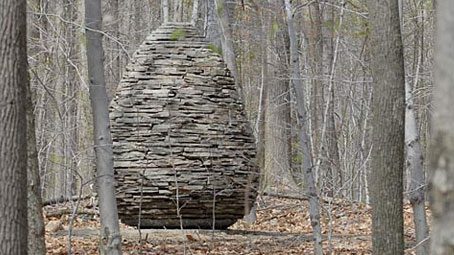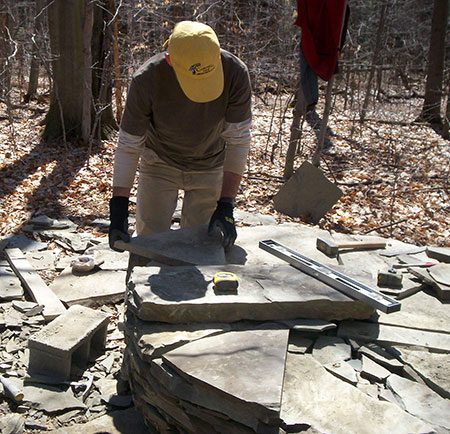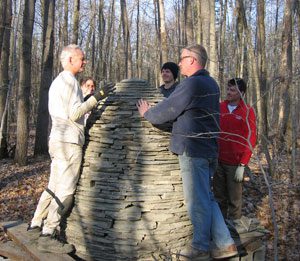Andy Goldsworthy and the Sapsucker Cairn
By Pat Leonard May 12, 2008
The latest work by internationally acclaimed environmental artist Andy Goldsworthy is tucked away in a quiet corner of Cornell’s Sapsucker Woods Sanctuary—a stone cairn standing sentinel beside the trail. Goldsworthy built the cairn out of locally quarried stone, assisted by Cornell students from a variety of programs.
“It’s a great location to make it. You kind of get a real feel for a place,” he says. “It fits in very well conceptually with what I’ve done at Cornell.”
The cairn is a recurring form in Goldsworthy’s work. He has created them out of tree branches, ice, and stone. But “Sapsucker Cairn” is probably the last one he will make. Goldsworthy says he feels he’s taken the form as far as it can go. “It may rear its head again,” he says, “But it would have to be something that would push the idea in a new direction.”

Goldsworthy, who is English but has lived and worked in Scotland for 22 years, is well known for building sculptures using only natural materials—be they a curtain of intricately woven branches linked with thorns, a carpet of brilliant yellow leaves, or sinuous extensions of a tree’s natural roots made of mud and moss. The textures of natural substances seem to fascinate him. He studies how they feel, how they react to wind, rain, sun, human hands… and time.
“I’m really attracted to the aesthetic of decay in his work and the idea of working with that… and all the tensions that are in that,” said Cornell senior Shern Kier, who has assisted Goldsworthy on the cairn and other projects. Goldsworthy says his work is an ongoing effort to come to grips with impermanence and the relentless force of time. Photographs are an important part of the process. They capture the changing shapes of ephemeral works as they break down and eventually disappear.
Goldsworthy says there are “loads” of materials out there he hasn’t tried yet. “It would be interesting to make something out of maple syrup. There are so many materials I haven’t worked with yet, and a lot of materials I haven’t worked well with yet.”
The construction of “Sapsucker Cairn” was funded by the Program for Andrew D. White Professors-at-Large and marks the waning days of Goldsworthy’s tenure as an A. D. White Professor-at-Large. The Program began in 1965 to bring distinguished scholars to Cornell to interact with students and faculty.

During a public lecture in Kennedy Hall, Goldsworthy talked about projects he’s done with Cornell students during his eight years as a Professor-at-Large—works created at the Metropolitan Museum of Art, The Neuberger Museum of Art, the National Gallery of Art, private installations, and Sapsucker Woods.
“It’s been one of the most unique experiences I’ve had at Cornell, getting to meet and work with Andy,” said Kier. “I felt like I had the opportunity to be brought into a different world.”
Goldsworthy produced numerous ephemeral works on campus, along Fall Creek gorge in 1999 and 2000, using brilliant red and golden leaves, and which are long since gone. Four replacement boulders for his Garden of Stone installation are on indefinite loan from the Museum of Jewish Heritage in New York City, and can be found at the east end of the F. R. Newman Arboretum. Garden of Stone, which is permanently installed at the Museum of Jewish Heritage in New York, honors victims of the Holocaust, and comprises living trees springing from eighteen large granite boulders.
To find the Sapsucker Woods cairn, follow the Hoyt-Pileated Trail that begins across the road from the main entrance to the Cornell Lab of Ornithology. The cairn sits on the right, a few minutes’ walk down the trail. If you don’t have the opportunity just now to visit the Cornell Lab in Ithaca, New York—or if you’re interested in seeing the artist at work—here’s a video about the construction of Goldsworthy’s cairn.

All About Birds
is a free resource
Available for everyone,
funded by donors like you
American Kestrel by Blair Dudeck / Macaulay Library
